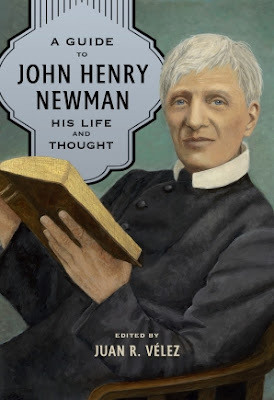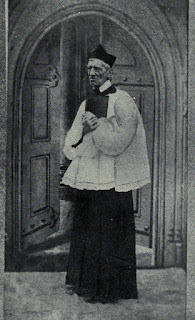Newman and the Liturgy: From Withey to Lang and Velez
 As noted recently, I'd dipped into Donald A. Withey's John Henry Newman: The Liturgy and the Breviary, Their Influence on His Life as an Anglican (London: Sheed & Ward, 1992), and used some information gleaned from it to comment on Newman's friendship with Isaac Williams. Then I finished the book and turned to Father Juan Velez's excellent survey of Newman's life and thought to read an essay on Newman and the liturgy there.Donald A. Withey, who served on the Committee for Pastoral Liturgy of the Bishop's Conference of England and Wales and other liturgical organizations, also wrote Why Receive the Chalice? (1990) and Catholic Worship: An Introduction to Liturgy (1990/2002), and edited Adult Initiation (1989).
As noted recently, I'd dipped into Donald A. Withey's John Henry Newman: The Liturgy and the Breviary, Their Influence on His Life as an Anglican (London: Sheed & Ward, 1992), and used some information gleaned from it to comment on Newman's friendship with Isaac Williams. Then I finished the book and turned to Father Juan Velez's excellent survey of Newman's life and thought to read an essay on Newman and the liturgy there.Donald A. Withey, who served on the Committee for Pastoral Liturgy of the Bishop's Conference of England and Wales and other liturgical organizations, also wrote Why Receive the Chalice? (1990) and Catholic Worship: An Introduction to Liturgy (1990/2002), and edited Adult Initiation (1989).In John Henry Newman: The Liturgy and the Breviary, Their Influence on His Life as an Anglican, he is focused on Newman's interests in the celebration of the prayers and liturgies of the Book of Common Prayer and his use of Roman (Catholic) Breviary and involvement in projects to translate and publish it for Anglican use. In chapter nine Withey considers Newman's conversion in light of his understanding of the liturgy and his use of Roman Breviary, especially in his Littlemore retreat while writing the Essay on the Development of Christian Doctrine.
The Table of Contents:
List of Illustrations AcknowledgementPreface
Part One: Newman, The Liturgy and the Roman BreviaryOne. BeginningsTwo. Newman and the LiturgyThree. Newman and the BreviaryFour. The Breviary Translation Project - Phase OneFive. The Breviary Translation Project - Phases Two and ThreeSix. The Sarum Breviary ProjectSeven. The Breviary Offices at LittlemoreEight. Newman's Writings on the Daily OfficeNine. Outcome: 'This is a Religion'
Part Two: Newman's TranslationsTen. Ten TranslationsEleven. Notes on the Translations
AppendicesOne. [Liturgical] Tracts for the TimesTwo. [List of] Newman's Sermons of Liturgical InterestThree. Newman's Two Prefaces to Hymnae Ecclesiae
NotesSelect BibliographyIndex
Withey quotes often from the letters between Newman and others working on the Roman Breviary translation project one through three; he had access to the Birmingham Oratory Archives in the days when not all of Newman's letters and diaries were available in print.
The Tractarian interest in the liturgy of the Book of Common Prayer began with lectures by Charles Lloyd, Regius Professor of Theology and later Bishop of Oxford. In 1825 he published Formularies of Faith Put Forth by Authority during the Reign of Henry VIII. Newman had attended his private lectures and after Bishop Lloyd died on May 31, 1829, Newman wrote to his sister Harriet (6/4/1829):
I had the greatest esteem, respect, and love for him as a most warm-hearted, frank, vigorous-minded and generous man. His kindness for me I cannot soon forget. He brought me forward, made me known, spoke well of me, and gave me confidence in myself. I have before my mind various pictures of what passed in his lecture-room; how he used to fix his eyes on me when he was pleased, and never put his Ch. Ch. friends unduly forward. I wish he ever had been aware how much I felt his kindness. [Letters and Correspondence: 1827-1829]
The other great influence on the Tractarians regarding liturgy was Origines Liturgicæ by William Palmer of Worcester College (not the William Palmer of Magdalen College).
Newman restored elements of the Prayer Book liturgy at both St. Mary's in Oxford and St. Mary's-St. Nicholas' in Littlemore, including Morning and Evening Prayer read aloud in church and Sunday Communion services. Withey also credits Newman with "introducing the nineteenth century Church of England to office hymns" (p. 91)
In the chapter on the Sarum Breviary translation project I learned that:
Perhaps the last chapter was the best: "Outcome: 'This is a Religion", in which Withey traces the three phases of Newman's progress to the Catholic Church and the "part played by his understanding of the Liturgy, and especially by his encounter with the Roman Breviary." (p. 102)
Because of the conditions in sixteenth century England [that is, Recusancy, Penal Laws, Martyrdoms, etc], no attempt was made by Roman Catholics to secure the continued use of the Sarum Breviary under the provisions of the the Bull Quod a nobis, which allowed for missals and breviaries with at least two hundred years of continuous use to be continued to be used. (p. 68)
According to Withey's schema the first phase was "his search for the identity of the Church of England." (p. 102) At that time he believed that the Church of England was a part of the Church Catholic, one, holy, and apostolic (Credo!) as the Via Media. The second phase, through his study of the Fathers of the Church and the Anglican divines revealed to him that it might not be that Via Media at all--the Monophysite heresy and Wiseman's Dublin Review article, with the echoing refrain "securus judicat orbis terrarum"--contributed to those doubts. And third, when Newman began to test the Roman Catholic Church's claim to be that Church Catholic he sought: that's when studying Saint Athanasius and the Arian heresy mirrored what he'd found in his study of the Monophysite heresy: Rome was the One upholding the true doctrine of the Incarnation! (pp 104-105)
And the role of the liturgy--although barely mentioned in the Development of Doctrine--was that, according to Withey, Newman saw the Church "as an integrated body, made up of interrelated elements, one of the most important of which was the sacramental principle" (p. 107). In some ways, Withey anticipates some of Father Ian Ker's argument in Newman on Vatican II (OUP: 2014), but in such compressed form that it can compare with Father Ker's analysis.
Once Newman--as Chesterton would later say--started looking at the Catholic Church from the inside through the Roman Breviary and being fair to the Catholic Church by studying the Fathers of the Church and their times, he came to assent to the Truth and to become a member of the "one true fold of Christ".
I appreciated Dr. Withey's detail and narration and would recommend this book to those interested in this aspect of Newman's life.
Turning to chapter 21 in A Guide to John Henry Newman His Life and Thought , (which is now available in paperback!) "From the Book of Common Prayer to the Sacrifice of the Mass and the Roman Breviary by Father Uwe Michael Lang (of the London Oratory) and Father Juan R. Velez (of Opus Dei and the editor of the book), here are the chapter headings:
Anglican Liturgy in the Early Nineteenth Century --Important for context and the most essential liturgical ideas in Cranmer's Book of Common Prayer: there is no Sacrifice re-represented in the Communion Service and the rejection of Transubstantiation
Newman: From Evangelical to Anglo-Catholic Views --Highlights Newman's "understanding of the Mass as a sacrifice. For Newman, it became evident that the altar (thusiasterion) for the early Christians implied a sacrifice (prosphora) and sacrifice implied priesthood." (p. 379)
Newman and the Tractarians: Underlying Principles --Includes this discussion of the Ritualism movement in the later stages of the Tractarian movement (see John Shelton Reed's Glorious Battle: The Cultural Politics of Victorian Anglo-Catholicism from Vanderbilt University Press)
Newman at Littlemore and Rediscovering Catholic Tradition --Not much added to Withey's discussion of Littlemore and the Roman Breviary, etc
Newman as a Catholic Priest --Notes Newman's comfort in the Eucharistic Presence of Christ in the Tabernacle; mentions Newman's aims in building Our Lady Seat of Wisdom for the Catholic University of Ireland in Dublin, its Byzantine/Romanesque style.
 Catholic Sense of the Liturgy Cites Alcuin Reid's The Organic Development of the Liturgy's two pages (pp 67-69) on Newman as exceptional; otherwise comments on Romano Guardini's Spirit of the Liturgy (not much Newman)
Catholic Sense of the Liturgy Cites Alcuin Reid's The Organic Development of the Liturgy's two pages (pp 67-69) on Newman as exceptional; otherwise comments on Romano Guardini's Spirit of the Liturgy (not much Newman)Conclusion --"Once he became Catholic, he truly found peace and serenity in the liturgy, even in the midst of severe external trials, and his prayerful dedication to the Church's divine worship made his priestly life exemplary." (p. 397)
Suggested Reading
Fathers Lang and Velez highlight Withey's book as the only monograph study on Newman and the Liturgy and note that neither the Oxford nor Cambridge guides to Newman contain essays on that subject and in fact, there are few studies of Newman and the Liturgy. One they do not mention is here by Father Guy Nichols of the Birmingham Oratory which highlights Newman's contributions to the liturgy at that church, architecturally and musically. Father Lang contributed this article to the Adoremus Bulletin.
There you have it: some notes on Newman and the Liturgy as an Anglican/Tractarian and as a Catholic/Oratorian priest.
Published on June 07, 2024 22:00
No comments have been added yet.



